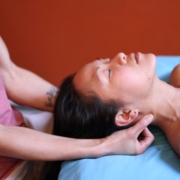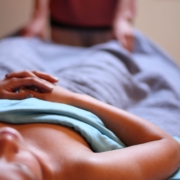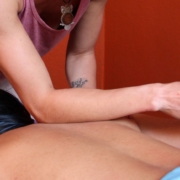Massage Therapy for Headaches
Massage has long been a treatment for a variety of ailments and symptoms, but did you know that massage therapy is also a very helpful tool for dealing with common headaches? Read on to understand how you can help decrease the frequency and strength of headaches.
Common Types of Headaches
Every headache is not the same. You are probably aware of this as headaches feel differently depending on where they are located around your head. Before I discuss how massage therapy can help relieve headaches, first let me explain and differentiate the most common kinds of headaches, divided into three main categories.
Tension-Type Headache
Tension headaches are the most common type of headache. Tension headaches are often described by people as if they were wearing one of those sports headbands that is slowly tightening around their heads. Other people will say it is like having a ‘vise’ around their heads. They are divided into infrequent (less than 12 a year), episodic (occurring less than 15 days a month over 90 days) or chronic (which occur more than 15 days a month over 90 days). Symptoms of tension headaches often also involve pain in the shoulders, the neck and in the surrounding muscles. Because of this, people who experience them often have difficulty sleeping. Unfortunately, the causes aren’t completely understood, but we will discuss below how massage therapy can help. What is understood is that these headaches are likely triggered by emotional stress and muscle tension and in part caused by how the brain is interpreting the signals sent from the muscles of the head and neck.
Vascular Headache
A vascular headache is an outdated term to describe certain types of headaches which were thought to be related to blood vessel swelling and hyperemia as the cause of pain. Today, vascular headaches are described by more accurate sub-categories such as cluster headaches, migraines and sinus headaches which I will discuss below.
Classic Migraine
First, the classic migraine, or sometimes called the migraine with aura, is a recurring headache that strikes after or at the same time as sensory disturbances called aura. These disturbances can include flashes of light, blind spots, and other vision changes or tingling in the hand or face.
Migraine aura symptoms include temporary visual or other disturbances that usually strike before other migraine symptoms such as intense head pain, nausea, and sensitivity to light and sound. Migraine aura usually occurs within an hour before head pain begins and generally lasts less than 60 minutes. Sometimes migraine aura occurs with little or no headache, especially in people age 50 and older. People who have migraine with aura develop temporary visual signs and symptoms which tend to start in the center of the field of vision and spread outward. These might include:
- Flashes of light
- Blind spots, which are sometimes described as geometric designs
- Zigzag lines that gradually float across your field of vision
- Shimmering spots or stars
- Changes in vision or vision loss
Aura-less Migraine
Migraines without auras are much more common than any other kind. You can get them as often as several times a week or as little as once a year. Auras show up in about 1 in 3 people with migraines, but you’re not likely to get them every time. So, it’s possible you might have both types of migraine, with auras happening here and there.
Unlike aura migraines, aura-less migraines do not cause pain. However, they may produce other debilitating symptoms, including upset stomach, dizziness, and sensitivity to light or sound. Migraines are a prevalent health issue worldwide. A 2015 study reported that 14.3 percent of adults in the United States had experienced a migraine or a severe headache within the previous 3 months.
Cluster Headache
Cluster headaches are often described as the most painful form of headache. While they are rare, when they do happen, they come on quickly and often include migraine-like symptoms of auras and even nausea. Fortunately, they are not life-threatening, and they usually go away as quickly as they came, and can be treated. Common signs and symptoms of cluster headaches are:
- Excruciating pain that is generally situated in, behind or around one eye, but may radiate to other areas of your face, head, and neck
- One-sided pain
- Restlessness
- Excessive tearing
- Redness of your eye on the affected side
- Stuffy or runny nose on the affected side
- Forehead or facial sweating on the affected side
- Pale skin (pallor) or flushing on your face
- Swelling around your eye on the affected side
- Drooping eyelid on the affected side
Cluster headaches usually only last 30 to 90 minutes. They can be as short as 15 minutes or as long as 3 hours, but then they disappear. Some people get one to three of these headaches a day. But some people have as few as one every other day, while others get them up to 8 times a day. They have been found to be connected with our circadian rhythm, the internal clock that regulates our sleep. Therefore, they often happen at the same time each day.
Sinus Headache
The sinus headache often feels like there is an infection of the sinuses like sinusitis, and people who get them describe pain and pressure around their eyes, cheeks, and foreheads.
Sinusitis usually occurs after a viral upper respiratory infection or cold and includes thick, discolored nasal mucus, decreased sense of smell, and pain in one cheek or upper teeth. Headaches due to sinus disease often last days, much longer than typical migraine headaches
Traction-Inflammatory Headache
Traction or inflammatory headaches can be a warning sign for a more severe condition. A traction headache can occur when the pain-sensitive parts of the head are pulled or stretched (such as with eyestrain). Inflammatory headaches are those that result from diseases of the sinuses, spine, neck, ears, and teeth. Both traction headaches and inflammatory headaches can be signals of serious disorders, such as brain tumors, strokes, and head trauma. They require immediate medical attention
Headache Relief Massage Techniques
Now that I have discussed the various forms of headaches, let’s talk about relief! I will discuss several massage techniques as well as lifestyle changes that you can make to decrease the frequency and severity of headaches that you may experience
Deep Tissue Massage
Deep tissue massage is a type of massage therapy that focuses on realigning deeper layers of muscles and connective tissue. It is especially helpful for chronic aches and pains and contracted areas such as stiff neck and upper back, low back pain, leg muscle tightness, and sore shoulders. Deep tissue massage uses long, deep strokes that help relax strained muscles, muscles that are often the cause of the various forms of headaches described above. There is a lot of research available that suggests that head pain is connected with muscle tension in the rest of the body. Deep tissue massage can also include the facial, neck and shoulder muscles to help relieve pain.
Trigger Point Massage
Trigger point massage focuses on releasing tension points, which are small, bound up adhesions that develop in muscles and connective tissue that may cause pain in other areas of the body. When pain occurs in another area than it is caused, this is called referral pain. Trigger point massage can be uncomfortable and even painful, and not as relaxing as a traditional Swedish massage. However, regular sessions are very likely to help reduce the frequency and severity of headaches and with regular treatment, it may also help improve your alignment, your posture and even range of motion
Other Headache Relief Ideas
Finally, there are a few options to reduce the pain and severity of headaches that you can do completely on your own – stress management and self-massage. Both are low cost and important tools for headache relief.
Stress Management
Research has shown that high levels of stress contribute to a wide variety of health issues, including increased headaches. Stress is often responsible for tightened muscles in the body causing the different forms of headaches described above. We all live very busy lives. Headaches are more likely to occur when you’re stressed. Stress is a common trigger of tension-type headaches and migraine, and can trigger other types of headaches or make them worse. But stress doesn’t have to go end up in a headache! There are some simple things you can do to help break the stress cycle, such as relaxation techniques like meditation, tai chi, deep breathing, and yoga. Getting more sleep helps, along with regular exercise, a healthy diet, and a slower pace. Try finding something you really enjoy doing that is relaxing for you – walking in the morning, reading a book, spending time with children and animals. Anything that helps relax you and reduce your stress will help keep tension out of your system, thus reducing headache frequency and severity.
Self-Massage
Below is a simple set of self-massage exercises you can use to help with headache relief:
Technique # 1:
Use your thumbs to press firmly onto the bridge of your nose just below your forehead. Hold firmly for 15 seconds while taking deep breaths, repeat 3-5 times.
Technique # 2:
Use your thumbs again to press firmly above the bridge of your nose towards your forehead. Hold firmly for 15 seconds while taking deep breaths, repeat 3-5 times.
Technique # 3:
Use both hands to lightly pinch your eyebrows for 15 seconds. Repeat 3-5 times while taking deep breaths.
Technique # 4:
Use your fingers to press firmly into your temples in a circular motion for 15 seconds. Repeat 3-5 times while taking deep breaths.
Foam Roller
With a foam roller or two tennis balls taped together, roll along your upper back to reach your upper trapezius and rhomboids.
These are a good tool for getting connected with your body, relax, and minimize the stress patterns causing headaches. In addition to self-massage, regular monthly massage that is focused on the areas of tension causing headaches will keep your stress levels manageable, and reduce the headache pattern.






Leave a Reply
Want to join the discussion?Feel free to contribute!